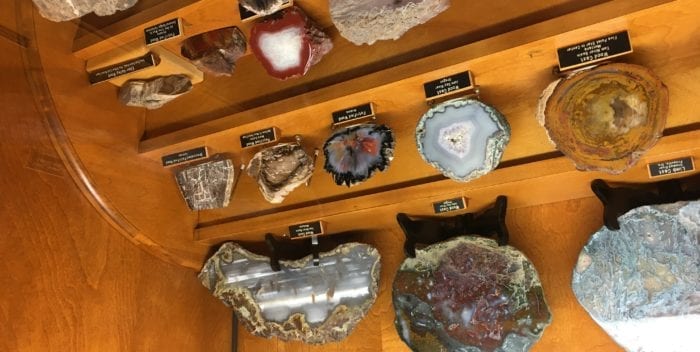Bartels Rock and Mineral Museum Spotlight
Photo Courtesy of Hannah Birtell
By Hannah Birtell
The Bartels Rock and Mineral Museum features rocks and minerals from across the world.
Located in the basement of the Link Library, the museum contains upwards of 16,000 rocks in 85 different displays. The majority of the rocks come from the Bartel collection.
Walter and Ella Bartels were farmers from Clarinda, IA.
“For some reason,” museum curator Marvin Plamann said, “he (Walter) got interested in, probably with farming he may have plowed through some rocks, so he got interested in rocks and minerals and that. And eventually started collecting them.”
In 1983, the Bartels Museum was created after several years of talking about its creation.
“This was a fairly significant step,” Plamann said. “We didn’t have this room (the museum room in the basement of Link Library) available and so we did then gradually start with a few display cases.”
Plaaman said how the display cases started out just being in the science building, but eventually they were given the space in the library that they currently reside in.
The rocks and minerals that the Bartels donated encompass many different types of rocks. The most common display in the museum is Brazilian agate.
“Some of our Brazilian agate got framed up and has a nice metal frame, some is in the cabinet and then there is a hanging display,” Plamann said.
Besides Brazilian agates, the museum also displays agates from Lake Superior, Mexico and other countries around the world.
“There is one agate that is a German agate in the northeast part of the displays,” Plamann said. “It was part of the 1894 World’s Fair.”
The museum also contains a number of impressive geodes.
“It (geodes) are usually a ball-like structure with a lot of mineral calcite in it,” Plamann said. “Sometimes they were cut through and then you have a cavity or so forth. Or sometimes the cavities are almost full.”
There are also examples of petrified wood in the museum, even with some coming from Nebraska.
There are also a number of fossils on display at the museum. Some of the most impressive fossils on display are a mammoth tooth, a mastodon tooth, shark teeth and a bison skull, with some of the shark teeth and the bison skull being from Nebraska.
“One of our students and her family was on her family farm and they found this (the bison skull),” Plamann said. “Sometime was sticking out and they dug around and found a bison skull.”
Another unique display in the museum is a display of fluorescent rocks. The rocks are kept in a dark box with a switch to turn on a fluorescent light so that the rocks will glow in the dark. The museum also holds a few specimens from outer space, some of which came from the meteor crater in Arizona.
The rocks and minerals in this museum hail from all four corners of the world: Canada, Mexico, Brazil, Argentina, mid-America, Spain, Italy, Germany, England, Tanjanica, South Africa, China, India, Japan, Taiwan, the Philippines, Australia as well as many states across the United States.
In a normal year, the library hosts many school groups that come to visit as well as other visitors. While the museum is currently closed due to COVID, students can get a glimpse at some of what the museum has to offer by viewing the rocks and minerals on display in the Dunklau Center for Science, Math and Business.












